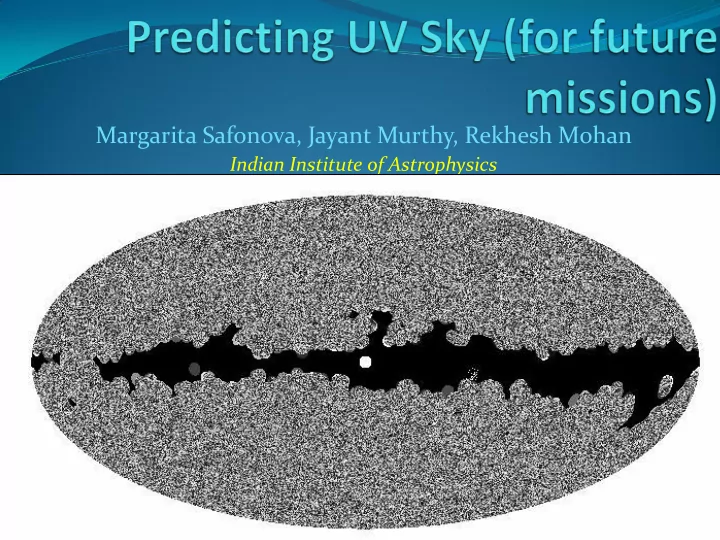

Margarita Safonova, Jayant Murthy, Rekhesh Mohan Indian Institute of Astrophysics
Keyword of modern astronomy — multiwavelength Universe Missions in orbit: • 1 UV – GALEX (+ EUV CHIPS studying the Local Bubble, Hubble) • 9 IR – Spitzer, IRAS, IRIS, Planck, Kepler, NICMOS(HST), Hershel, WISE • 4 X-ray – Suzaku, XMM, Chandra, RXTE • 3 γ -ray – INTEGRAL, Swift, GLAST Future UV Missions: • No new UV missions are planned by NASA or ESA • India: UVIT on AstroSat and Russia-led WSO Importance of UV: The Need for UV to Understand the Chemical Evolution of the Universe, and Cosmology Wamsteker et al. 2006 UV Capabilities to Probe the Formation of Planetary Systems: From the ISM to Planets Ana Gomez de Castro et al. 2006
UV sky Discrete source (hot stars, AGN, etc.) UV background (diffuse radiation field): Airglow (important in low-orbit missions) Zodiacal light (scattered sunlight in Solar System) Cosmic background (from beyond Solar System): Orbital dawn * Galactic component ( scattering of sunlight off dust grains) * Extragalactic component at the Time ~20’ poles up to 25%? [Brosch ’98] ) + Dark instrument count — usually ~5 cts/cm 2 UVX spectrometer on Columbia 1986 @ 330 km [Murthy ‘10] λ : 1200 1600 3200
Web-based Sky Simulator A simulation of the sky is important : - For the purpose of mission planning - To provide test data for development and validation of software pipeline Instrument-specific inputs: FOV Wavelength at which data/image to be generated Filter curves (currently old UVIT; user-uploadable) Dark count (not yet) Background contributors: Airglow (currently set @ 200 ph/cm 2 /sec/sr/Å; changeable) Zodiacal light (depends on time, date and direction of observation) Stellar contribution (now Hipparcos catalogue; will be uploadable) Galactic background (GALEX database)
Web-based Sky Simulator
Web-based Sky Simulator Airglow Important contributor to UV b/g for low-orbit missions, like GALEX and Astrosat Strongly depends on the altitude, observation time, zenith angle and solar cycle Strong function of the local time Distribution usually determined empirically Average level @~200 photons/cm 2 /sec/sr/Å [Sujatha et al. ‘09]
Web-based Sky Simulator Stellar contribution Major contributor to diffuse sky b/g is scattering of starlight on IS dust Used Hipparcos catalogue as data source (mags, distance, spectral type): 250,000 stars Kurucz models to get spectra [Kurucz ’92] Kurucz model scaled to V mags Convolved with instrument response function to get counts
Web-based Sky Simulator Galactic background Dominated by starlight scattered by IS dust Varies on spatial scales from arcmins to degrees Difficult to model [Murthy et al. ’10] Use GALEX database in FUV and NUV (pt source catalogue providing star flux with a background at its position); download median of backgrounds Interpolate between FUV and NUV using B star spectrum Subtract airglow and zodiacal light Tabulate derived backgrounds GALEX NUV b/g Galactic plane modelled cosec b by law [Murthy et al. ’11]
Web-based Sky Simulator Zodiacal light Essentially a solar spectrum scaled to the UV; contributes only to NUV Level depends on time and date of observation, look direction Online Calculator The online calculator is a front end to the C program. The only inputs required are the date and the observing direction. The output is the zodiacal light spectrum in units of photons/cm 2 /s/sr/Å plotted as a function of wavelength. This can be integrated with the filter response function to give a count rate in each of the filters. The spectrum itself can be downloaded by clicking on the image. Implementation Problem Statement : In order to calculate the zodiacal light, we need: Sun position ( I DL algorithm for the Solar ephemerids converted to C code) Zodiacal light spectrum (solar spectrum is from Colina et al. ‘96 ) Zodiacal distribution (spatial dependence as a function of ecliptic coordinates from table by Leinert et al. ’98) Input/Output The input of the program is: day-month-year : look_ra -look_dec The output of the program is the zodiacal light level at the specified coordinates n FOV and date in units of photons/cm 2 /sec and a plot of spectrum. Can also generate all-sky distribution
Web-based Sky Simulator All-Sky Zodiacal Light for April
Web-based Sky Simulator
Application to UVIT A A QE T OpticsEffi ciency ( ) ( ) ( ) eff geom F Ref: AstroSat Handbook
Application to UVIT BaF2 NUVB15 NUVB13 NUVB4 NUVN2 λ range 1300-1830 1900-2400 2200-2650 2445-2825 2730-2880 Δ effective 378.0 281.7 270.5 282.3 89.5 λ mean 1549.6 2435.5 2183.0 2428.0 2790.0 λ pivot 1544.6 2433.6 2181.0 2616.4 2789.7 λ effective 1232.3 2433.2 2171.0 2629.0 2792.0 d A ( ) Effective bandwidth eff norm A ( ) d norm Mean (central) wavelength mean A ( ) d norm A ( ) d eff 2 Pivot wavelength pivot A ( ) d eff A ( ) F ( ) d Effective wavelength (A1V star for BaF2; eff Vega for NUV filters) eff A ( ) F ( ) d eff
Web-based Sky Simulator for UVIT Or Orion on Ne Nebula
Web-based Sky Simulator for UVIT Or Orion on Ne Nebula
Web-based Sky Simulator for UVIT Components of the simulation: Hipparcos stars in UVIT NUVB2 Zodiacal light distribution in FUV B1 in January in ecliptic coordinates UV background in UVIT FUV-B1
Web-based Sky Simulator To do: Include user-uploadable catalogues Update new UVIT effective areas All-sky images in 5 UVIT filters for different seasons Flag for overbright areas for 5 UVIT filters (now assuming GALEX brightness limits), but eventually user-changeable NUV: 50,000 cps (F λ ~ 3.0 x 10 -11 erg/cm 2 /sec/Å) FUV: 15,000 cps (F λ ~ 9.0 x 10 -12 erg/cm 2 /sec/Å) Time-variability of the background for few UV astrometric standard fields
Recommend
More recommend